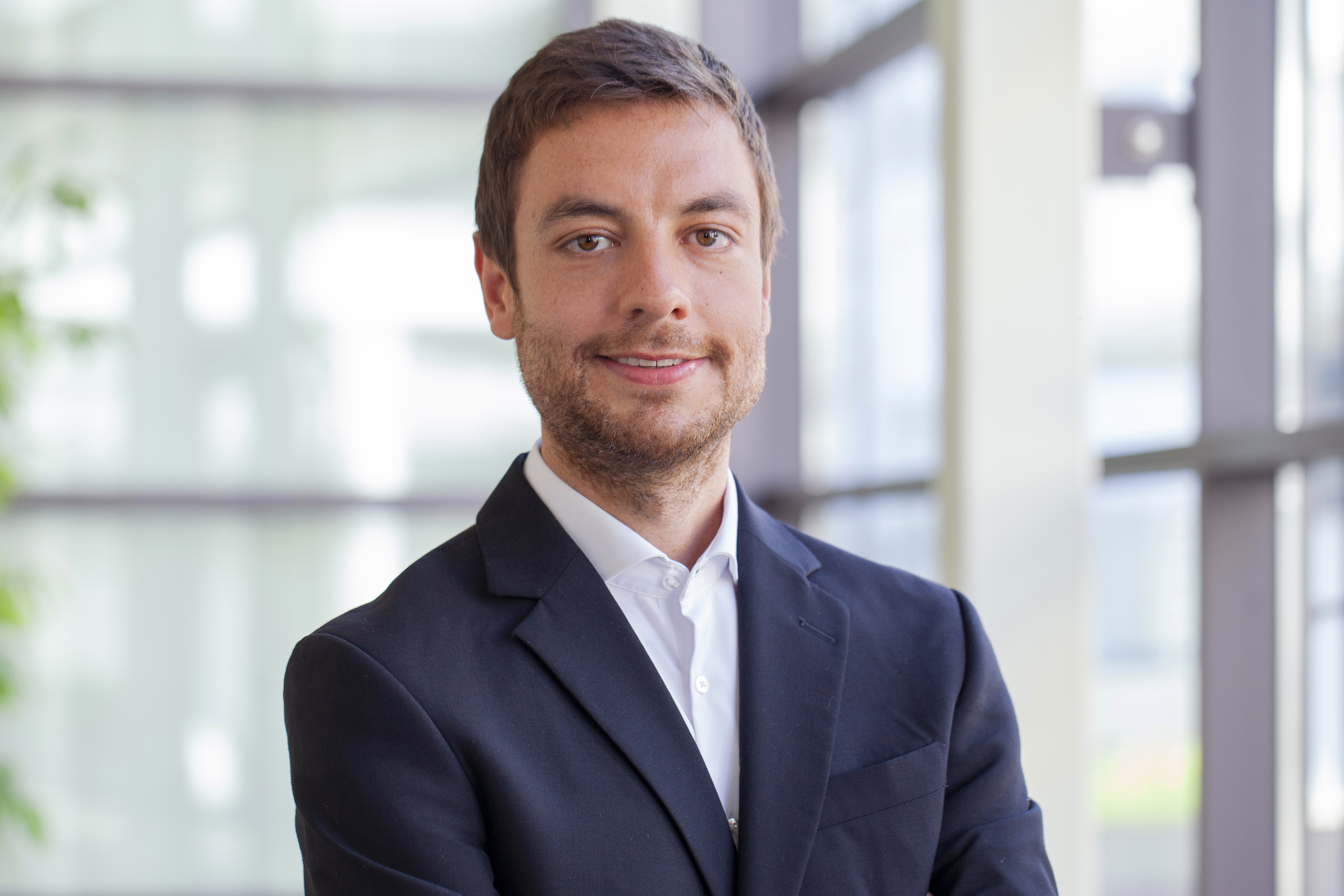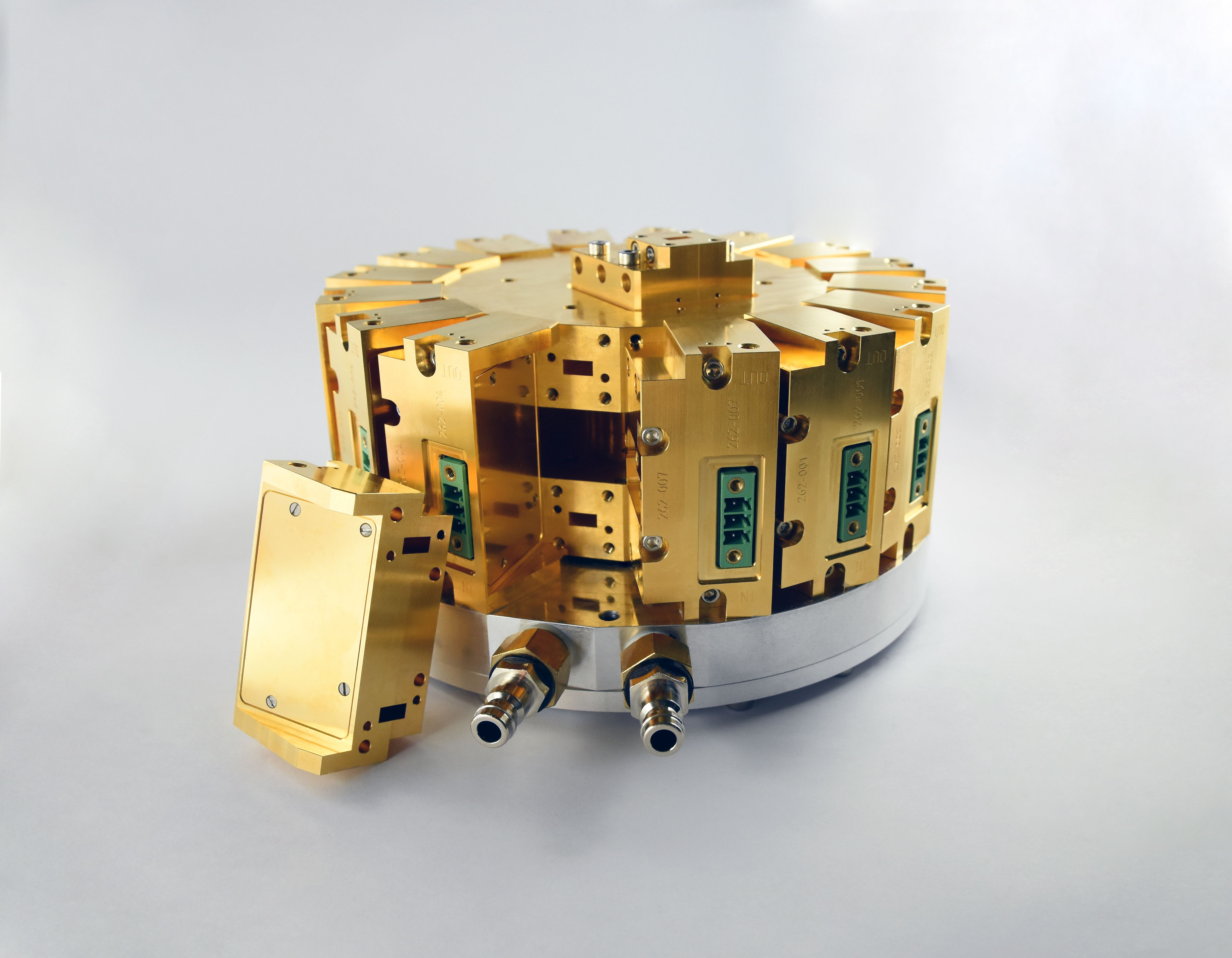Researchers at Fraunhofer IAF have developed a novel Solid State Power Amplifier (SSPA). In contrast to conventional power amplifiers, which strongly lose efficiency at increasing frequencies, the chips and the corresponding power combiner developed by Philipp Neininger during his doctoral research achieve extremely high powers of more than 100 W at frequencies of 28 – 38 GHz. This is due to their innovative system design and realization. To date, there is no comparable technology in these power and efficiency classes that achieves this bandwidth. The entire value chain from epitaxy and processing of the wafers to the design and manufacture of the modules for this system is located at Fraunhofer IAF.
Amplifier system with extremely high output power
In conversation with Philipp Neininger, PhD student at Fraunhofer IAF

How and when did you come to Fraunhofer IAF?
I started an internship at Fraunhofer IAF in April 2016 after I was able to visit the institute for a guided tour as part of a lecture in Quantum Effects and Semiconductor Technologies, which impressed me a lot. After my master thesis, I then started my PhD in June 2017 and have been at the Fraunhofer IAF ever since.
What is it about chip design that fascinates you?
I have been interested in chip design for a long time and it has always been my goal to work in this field. I find it particularly fascinating that chips are so complex both on a purely physical level and in their functional potential. It is very exciting to see how chips do something in their functions that you have invented yourself.
In my current work, I combine chip design with high-frequency electronics. This is very complicated, but even more exciting. In high-frequency electronics, the difficulty lies, among other things, in signal routing. At extremely high frequencies, it is therefore important to see the big picture and plan both the structure and the chip design alongside each other.
Did it help you in that respect that both construction and design could take place at Fraunhofer IAF?
That was definitely helpful. The fact that the Fraunhofer IAF enables an enormous range of production means that we can respond individually to requirements. This is the basis that allows us to produce prototypes in which the overall structure is perfectly matched to the requirements. The results can then set new benchmarks in the state of the art. Collaboration with colleagues from the field of high-frequency electronics was essential for my work.
What exactly is your doctoral project?
In general, the aim was to circumvent the power loss in power amplifiers that occurs, for example, in signal transmissions in the high-frequency range. For this purpose, I developed an amplifier system with very high output power for high broadband frequencies. Until now, it was the case that less power could be generated at higher frequencies, which severely impairs the efficiency of power amplifiers. The goal of my work was to combine as many of the chips we made as possible with as little loss as possible and route them to a common output. At the same time, this design should allow for a very wide bandwidth, which increases the versatility of such systems and thus offers many different applications and higher data rates.
What distinguishes our system from conventional ones are, on the one hand, the broadband chips themselves, which have cover high bandwidths. On the other hand, the power combiner, which must be both broadband and low-loss. In these power and efficiency classes, there have been no chips or power combiners that had this bandwidth before. What was special about our development was that we enabled both very high power (with well over 100 watts) in this frequency range and at the same time managed to cover this entire band (from 28-38 Ghz) with such high power

What has been your personal highlight at Fraunhofer IAF so far?
I think it's great how much I was able to learn in such a short time and that I was given the opportunity to develop quickly. In my studies, I had focused on micro- and nanoelectronics and had to reorient myself with regard to working in high-frequency electronics. I was particularly encouraged by the fact that other employees in this field were very open and willing to share their knowledge and experience with me. This helpfulness and openness definitely characterize the environment at IAF. For this reason, I would recommend working at the IAF to students who are looking for an interesting job after university.
What's next for you after your doctorate?
I will stay at Fraunhofer IAF and would like to develop further in the direction of project management. However, I am also looking forward to being able to do something in the field of design again after writing the dissertation.
How would you describe the Fraunhofer IAF in 3 words?
Pioneering, Approchable, Varied
Philipp Neininger completed his Bachelor and Master of Science at the Karlsruhe Institute of Technology in 2014 and 2017, respectively. Between 2017 and 2021, he completed his PhD in chip design and high-frequency electronics at Fraunhofer IAF. In the course of this, he realized an innovative technology demonstrator of a gallium nitride-based amplifier system (SSPA).
 Fraunhofer Institute for Applied Solid State Physics IAF
Fraunhofer Institute for Applied Solid State Physics IAF